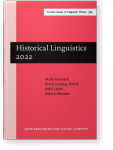The diachronic typology of retroflex vowels
This paper presents the results of a study on the possible diachronic pathways that lead to so-called
rhotic or retroflex vowels. Based on a historical-comparative examination of several unrelated areal clusters and individual
languages which contain retroflex vowels, in particular in the Hindu Kush area, China and California, a variety of possible
sources for retroflex vowels could be identified. Ultimately these can be reduced to three separate in-paths with two
different underlying mechanisms.
Article outline
- Introduction
- Pathway 1: Lenition of apical or retroflex consonants
- Pathway 2: Persistence of retroflexion from onset
- Pathway 3: Retroflex vowels from front rounded vowels
- Conclusion
- Author queries
-
Note
-
References
This content is being prepared for publication; it may be subject to changes.
